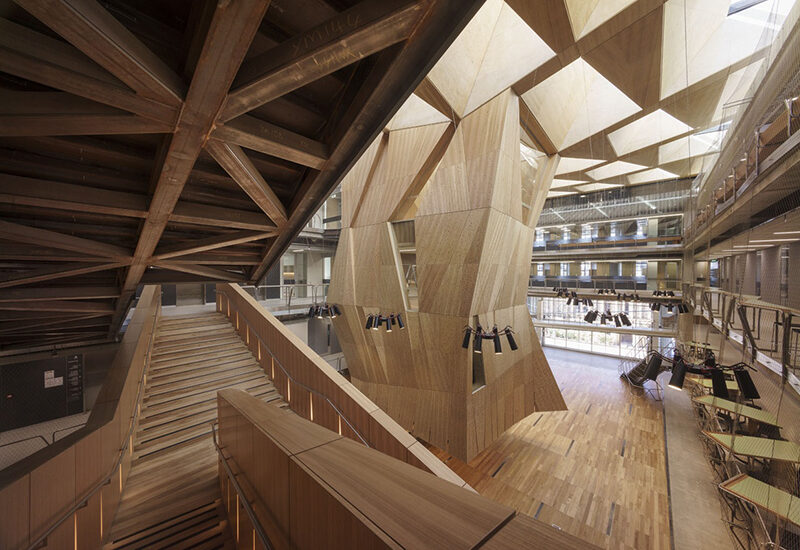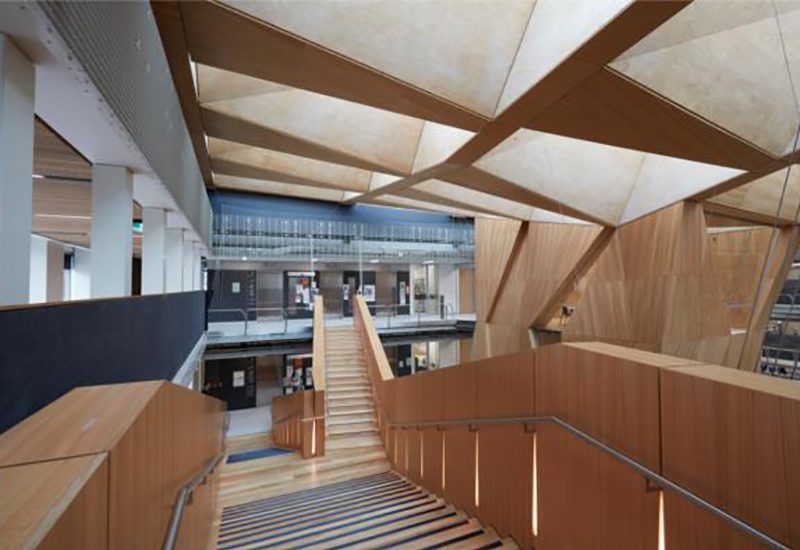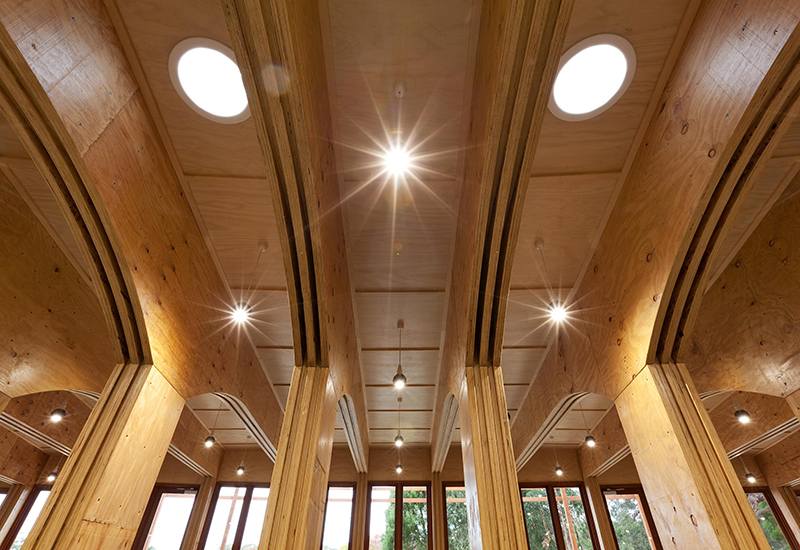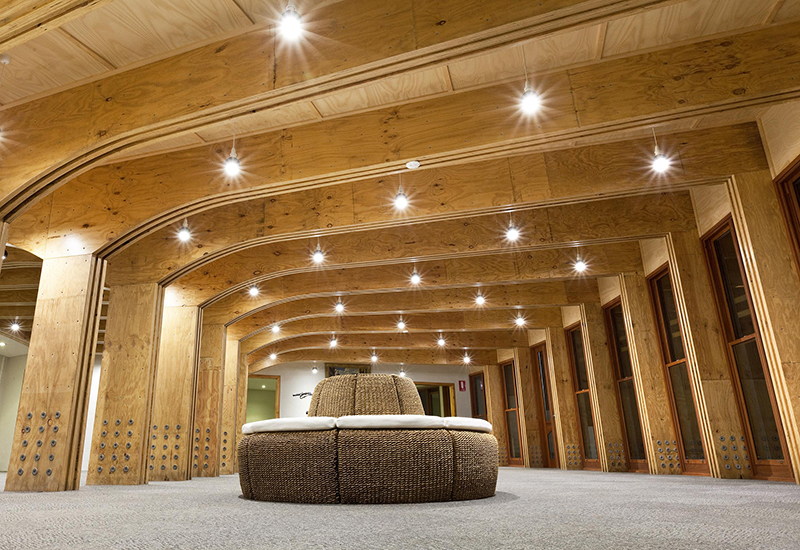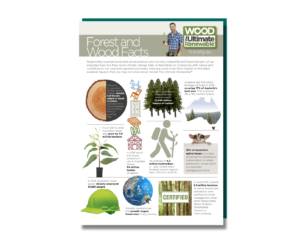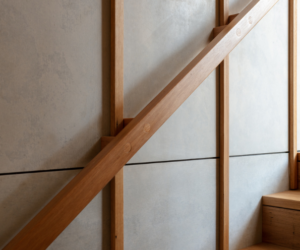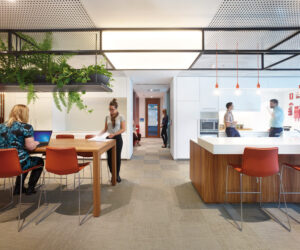A Lesson in Wood
Chosen by many for its architectural and aesthetic prowess, wood and wood products can also enhance our health and focus. This power means that timber is the perfect material to include in educational environments like schools and libraries. Here are some projects that maximise the benefits of timber to teachers and students.
The Candlebark School Library was designed by Melbourne architect Paul Haar. The site is in a designated bushfire prone area in the Macedon Ranges, meaning this building had to fulfil the dual criteria of serving as a traditional library and providing a wildfire refuge. To satisfy this objective, the windows and external doors of the library were framed in recycled blackbutt – a durable and fire-resistant hardwood.
Inside, timber also takes centre stage. The timber portal frames are exposed and the ceilings are lined with hoop pine plywood and finger-jointed hoop pine trim. Biophilia (the behavioural design theory that aligns increased feelings of wellbeing with exposure to elements of nature) is extended right down to the work surfaces. The bookshelves and study tables were built from a mixture of timbers – a wise move considering ongoing research into the effects of timber. For example, one year-long study examined 36 high school students taught in either classrooms furnished with solid wood or artificial finishes and found that students taught in the wooden classrooms had decreased heart rates and lower perceptions of stress.
Another exemplary project is John Septimus Roe Anglican Community School (JSRACS) Senior Learning Centre: Mirrabooka Campus. All structural elements, including ceilings, wall linings and cabinetry are made from timber.
Designed by Tom Brooking of Brooking Design Architects Pty Ltd, this project is impressively environmentally-minded. All primary timber structures, as well as panelling and cabinetry were crafted from FSC-certified timber. Sustainability is apparent in every detail – the glue used is a soy-based, formaldehyde-free product and the plywood face coating is water-based, non-toxic and non-harsh odour emitting.
Timber is well suited to learning environments because it has been proven to reduce emotional distress. A 2010 study of responses of 119 students in wood and non-wood offices before, during and after working on a stressful task concluded that subjects in the wood office indicated lower stress levels.
As well as promoting wellbeing, timber is at the forefront of innovation. Prefabricated timber’s strengths are made abundantly clear in the Macquarie University Innovation Hub, designed by Luke Johnson, Nick Elias and Angel YiZhang from Architectus along with a team of experts. The brief called for a design that enabled future dismantling, relocation and reassembling, and engineered timber products were the perfect solution.
This project combines technology with architectural vision and cost effectiveness, an achievement for which it was rewarded as winner of the 2017 Australian Timber Design Awards in multiple categories.
Advanced prefabrication techniques were also used to create the Melbourne School of Design at The University of Melbourne. John Wardle Architects, in collaboration with NADAAA (Boston), created a six-level facility that includes a series of studio spaces, a studio hall and atrium, lecture theatres, a library, exhibition spaces and specialist workshop areas.
The structure of this building is made up of laminated veneer lumber (LVL) timber beams which span across the studio hall and atrium. Staggeringly, the largest of these beams is a whopping 20 metres long. By tactically exposing its materials and structures, this building piques the curiosity of the viewer and prompts learning. In fact, this project was conceived as a “living learning building”.
In Planet Ark’s Wood: Housing, Health, Humanity Report update, Darren McGregor, Principal at Marist College, Bendigo (winning project of the 2016 Australian Timber Design Sustainability Category) observes that the presence of timber measurably benefits students. “The building and the atmosphere that has been created has had a noticeably calming effect on the students,” he shares.
Timber is selected by architects and developers for a host of reasons. The material offers speed of construction, technical innovation, sustainable values and cost effectiveness. In addition, the documented health and mental benefits of wood provide motivation to feature timber in places of learning.
Less work has been done on the effects of timber in domestic settings, but logic would suggest that many, if not all, of the benefits would apply equally to residential buildings and their occupants. So for happy, healthy families, would could be part of the solution!
References:
woodsolutions.com.au/inspiration-case-study/jsracs-senior-learning-centre
woodsolutions.com.au/inspiration-case-study/2017-atda-winner-macquarie-university-innovation-hub
woodsolutions.com.au/inspiration-case-study/melbourne-school-design
Wood – Nature Inspired Design. An update of the Wood: Housing, Health, Humanity Report
